Exploring October's Opal and Tourmaline Birthstones


Intro
October is a month not only known for its changing leaves and crisp air but also for its beautiful birthstones: Opal and Tourmaline. Each stone carries its unique set of properties and meanings, making them ideal for enthusiasts and collectors alike. Understanding these gemstones enriches the appreciation for their beauty and significance throughout history. In this article, we will explore the characteristics, historical importance, and cultural relevance attached to Opal and Tourmaline.
Gemstone Overview
Definition of Gemstones
Gemstones are precious or semi-precious minerals that are cut, polished, and used in jewelry or other decorative items. Their value is determined by various factors, including rarity, quality, and demand. Opal and Tourmaline stand out in the gemstone world for their vivid colors, intricate patterns, and distinct qualities.
Classification of Gemstones
Gemstones can be classified into different categories based on their physical properties and formation processes. Opals are classified as mineraloids due to their non-crystalline structure, distinct from traditional crystalline gemstones. Tourmaline, on the other hand, is classified as a silicate mineral group. Diverse in color and composition, Tourmaline is considered one of the most complex gemstones.
Historical Significance
Origins of Gemstone Use
Gemstones have been revered for millennia, valued not only for their aesthetic appeal but also for their alleged metaphysical properties. Opal has been seen as a symbol of hope, love, and purity, with its origins traced back to ancient civilizations. Tourmaline has also been appreciated, frequently associated with healing and protection. The use of these gemstones can be tracked back to the Romans, Greeks, and Egyptians, who imbued them with spiritual significance.
Cultural Insights: Gemstones in Ancient Civilizations
Many ancient cultures dedicated myths and legends to gemstones. For example, the Romans considered Opal a symbol of hope and purity. They believed it could bring good luck to its wearer. In contrast, the Egyptians viewed Tourmaline as a protective stone, often burying it with the dead to ensure safe passage to the afterlife. Such cultural insights reveal how gemstones transcended mere ornamentation, taking on vital roles in spiritual and daily life.
"Gemstones have always captivated human beings, reflecting a relationship intertwined with culture and significance."
The legacy of Opal and Tourmaline continues to be celebrated today. Their distinctive properties and historical importance make them a fascinating subject for any gemstone lover. As we move forward, this article will delve deeper into the specific features of both Opal and Tourmaline, examining their varieties, care instructions, and ongoing cultural relevance.
Foreword to October Birthstones
October is a month that carries the weight of cultural significance, with its two birthstones, Opal and Tourmaline, embodying a rich tapestry of history and meaning. Each gemstone carries unique physical properties and metaphysical beliefs that resonate with those born in this month. Understanding these stones is essential, not just for collectors and enthusiasts but also for anyone drawn to the beauty and symbolism of gemstones.
The significance of October's birthstones extends beyond their aesthetic appeal. These stones serve as a gateway to exploring emotional connections, cultural traditions, and historical relevance. Opal, with its brilliant play of color, and Tourmaline, with its diverse color range and unique properties, offer a dual perspective of beauty and complexity. They reflect not only personal identity but also cultural narratives that have evolved over centuries.
Furthermore, the study of Opal and Tourmaline provides insight into the ways human beings have interacted with natural resources. They are not merely decorative items but symbols of power, protection, and emotional healing in various cultures. Understanding their attributes enhances appreciation for fine jewelry, informs better choices for investment, and promotes proper care techniques, ensuring these treasures endure across generations.
In the sections that follow, we will delve deeper into the historical context of October birthstones, examine their physical properties, and unravel the symbolic meanings that these gems hold. This comprehensive approach not only enriches our knowledge but also enhances our connection to these remarkable gemstones.
Historical Overview of October Birthstones
The historical overview of October birthstones provides a vital context for understanding Opal and Tourmaline. This section highlights the evolution of these gemstones, tracing their significance from ancient cultures to contemporary society. Integrating their captivating stories enriches the appreciation for not only their physical beauty but also the deep emotional connections and beliefs tied to them. Understanding this history can enhance the enthusiasm of gemstone collectors, jewelry designers, and history enthusiasts alike.
Ancient Beliefs and Traditions
Both opal and tourmaline have deep roots in ancient civilizations. The opal was revered by Romans. They believed that possession of opal ensured good luck and protection. It was often called the "Gem of the Gods". Ancient Greeks thought opal bestowed foresight and prophecy. They associated opals with the goddess of love and beauty. This enriched the allure of this gemstone among all who interacted with it.
Tourmaline, with its wide range of colors, was equally significant. Ancient cultures often confused it with other gemstones. The name "tourmaline" comes from the Sinhalese word "turmali", which means "mixed gems". In India, tourmaline was cherished as a talisman against misfortune. Some tribes in Africa wore tourmaline to harness its powers for healing. Different colors of tourmaline were believed to affect different energies and emotional states. Its cultural importance underscored the gemstones' role in rituals and personal adornment.
Cultural Significance Across Eras
As time passed, the cultural significance of opal and tourmaline evolved. During the Middle Ages, opals were often seen as symbols of purity. They were thought to bring about the favorable qualities of all colored stones that might inhabit it. Monarchs and nobility favored opals for their beauty and rarity. In the 19th century, the discovery of the opal mines in Australia shifted the gemstone's status, making it even more coveted.
Similarly, the meaning of tourmaline transcended cultures. In the Victorian era, the use of tourmaline grew in popularity, as people began to appreciate its vast color ranges. Tourmaline was used to create intricate jewelry pieces designed for personal expression. It became known as a stone of reconciliation, believed to promote harmony among individuals.
In modern times, both opal and tourmaline continue to capture the fascination of many. Their unique characteristics and rich stories provide a significant reason to celebrate them as October birthstones. Understanding the historical context can influence the way they are perceived today, making them more than just beautiful gemstones.
Physical Properties of Opal
Understanding the physical properties of opal is essential in appreciating its unique nature and diverse varieties. This section will outline the optical characteristics, chemical composition, and the different types of opal, which play a crucial role in both its beauty and market value. For gemstone enthusiasts, collectors, and jewelry designers, recognizing these properties is fundamental when selecting pieces or crafting new designs.
Optical Characteristics
Opal is renowned for its fascinating optical properties. Its main appeal lies in the phenomenon known as play-of-color, which is the ability of opal to display a vibrant spectrum of colors when viewed from different angles. This optical effect occurs due to the unique arrangement of silica spheres within the stone, which diffract light as it passes through. The brightness of the play-of-color can vary, influencing the value of the opal. High-quality opals display vivid colors with strong brightness, while lower-quality stones may present a more subdued color scheme. These characteristics are essential for anyone assessing the beauty and value of opal in jewelry.
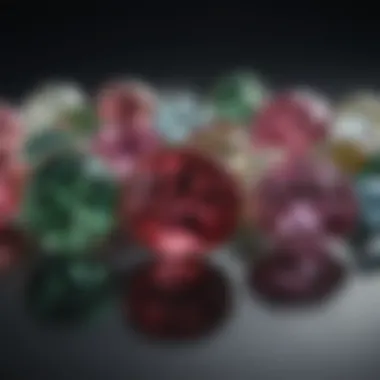

Chemical Composition
Opal is primarily composed of hydrated silicon dioxide, which is a combination of silica and water. Generally, the water content in opal can range from 3% to 21%, impacting its overall properties. This hydration contributes to the stone's luster and influences its stability. Impurities within the silicon dioxide structure, such as iron or aluminum, can also alter the color and appearance of an opal. Understanding this composition is vital for those in the gemstone industry, as it affects how opal behaves under different conditions and its suitability for various applications in jewelry.
Varieties of Opal
Opals come in several distinct varieties, each with its own characteristics and appeal. Recognizing these differences helps enthusiasts and collectors make informed choices about purchases or designs.
Precious Opal
Precious opal is the most sought-after variety due to its stunning play-of-color. The vibrant colors and patterns make it highly desirable in the world of luxury jewelry. Its unique feature is the ability to show different colors and patterns, which can be striking and attention-grabbing. However, precious opal can be more delicate and may require special care to maintain its appearance, making it essential for wearers to understand how to protect it.
Common Opal
Common opal does not exhibit the colorful play-of-color seen in its precious counterpart. Instead, it can come in solid colors or exhibit a milky appearance. The simplicity of common opal gives it a distinct charm and can be a more affordable option for those looking for gemstone jewelry. Its unique feature lies in its more subtle beauty and wider variety of color options. This makes common opal a popular choice for casual wear and everyday use.
Boulder Opal
Boulder opal is a unique type of opal that forms within ironstone boulders. It retains a portion of the host rock, giving it a distinct and rugged appearance. The key characteristic of boulder opal is the combination of the opal with its host, which lends it a earthy and natural feel. This variety is increasingly popular among collectors due to its uniqueness and the intriguing way it showcases opal. However, the extraction and polishing of boulder opal can be more labor-intensive, influencing its market value.
In summary, the physical properties of opal, including its optical characteristics, chemical composition, and variety, provide a solid foundation for understanding this captivating gemstone. Each type offers something unique for both casual wearers and serious collectors.
Physical Properties of Tourmaline
Understanding the physical properties of tourmaline is crucial for both enthusiasts and collectors. This gemstone exhibits a unique set of characteristics that sets it apart in the world of gemology. The analysis of these properties not only enhances appreciation but also informs decisions about care and investment.
Tourmaline is a complex mineral, with a crystal structure that affects its appearance and durability. It is essential to grasp these attributes to truly appreciate the multifaceted nature of this stone. Knowing how tourmaline forms and its different variants can help determine its value and practicality in jewelry making.
Crystal Structure and Formation
Tourmaline has a unique hexagonal crystal structure. This geometric configuration contributes to its stability and variety of colors. The crystal can be found in elongated prism shapes, which can often exhibit striations along their length. The formation of tourmaline occurs through a process called pegmatitic crystallization, where minerals crystallize in cooling magma.
What is fascinating about tourmaline is that it often contains specific elements like lithium, iron, and manganese, which directly influences its color. For example, the presence of manganese gives rise to the famous pink and red variants, while iron imbues the stone with green hues. This complexity makes tourmaline one of the most diverse gemstones.
Color Variants in Tourmaline
Tourmaline is renowned for its stunning color range, which can include nearly every color of the spectrum. Some popular variants include:
- Elbaite: This variety is known for its vivid colors, which can range from vivid pink to green and even blue.
- Schorl: Usually black or dark brown, this variant is often used in jewelry due to its attractive appearance and durability.
- Watermelon: This type consists of pink and green bands, making it particularly eye-catching.
- Indicolite: This rare form presents a beautiful blue color.
The notable aspect of tourmaline is its capacity for color zoning within a single crystal. A single piece may demonstrate multiple colors, which adds to its charm and appeal for jewelry designers. Each hue also carries its own unique symbolic meaning, which heightens its desirability among gemstone enthusiasts.
In summary, the physical properties of tourmaline serve as a window into its beauty and complexity. Acknowledging the crystal structure and the various color variants equips potential buyers and collectors with valuable knowledge, enabling them to make informed decisions about their purchases.
"Tourmaline's marvelous colors and intricate formations are a testament to nature's artistry. Understanding these properties opens a door to deeper appreciation."
Symbolism and Meaning of Opal
The symbolism attached to opals is layered and textured. As a birthstone for October, opal embodies emotional depth and holistic vitality. The iridescent hues of opal can reflect various moods and emotions, making it a stone of inspiration and creativity. Its transformative nature is particularly compelling, signifying change and new beginnings. In a way, opal is seen as a personal gemstone, resonating uniquely with its wearer.
Emotional and Spiritual Significance
Opals have a profound impact on emotional well-being. They are thought to amplify feelings, bringing underlying emotions to the surface. This can result in positive outcomes, like enhancing creativity and passion, but can also lead to emotional vulnerability. Wearing opal is sometimes recommended for individuals needing encouragement to express their feelings more freely.
From a spiritual perspective, opals are believed to facilitate a connection between the physical and ethereal realms. Practitioners of crystal healing sometimes use opals to promote intuition and spiritual growth. This gemstone serves as a reminder of the importance of inner truth and self-exploration. Its multifaceted nature can encourage personal transformation, aligning with one’s higher self.
Opal in Folklore and Myths
Opals have captured the imagination across cultures for centuries. Ancient Romans considered opals to be a symbol of hope and purity. They believed that the stone possessed the power to ward off evil, thus elevating its status in jewelry. The Greeks attributed opals to the gods, linking them to inspiration and foresight.
In more contemporary contexts, stories of opal’s mystical properties abound. One prevailing myth suggests that opals were once deemed unlucky if not worn in their original form. However, as perceptions shifted, opals have emerged in modern jewelry as symbols of faithfulness and loyalty.
"Opals are often seen as gems of opportunity, embodying the duality of light and shadow, creation and destruction."
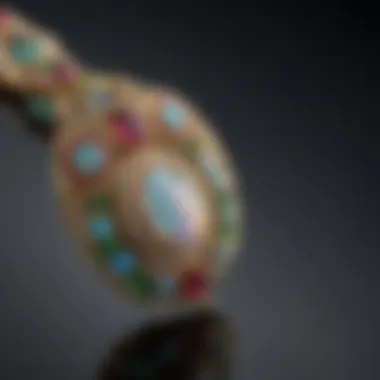
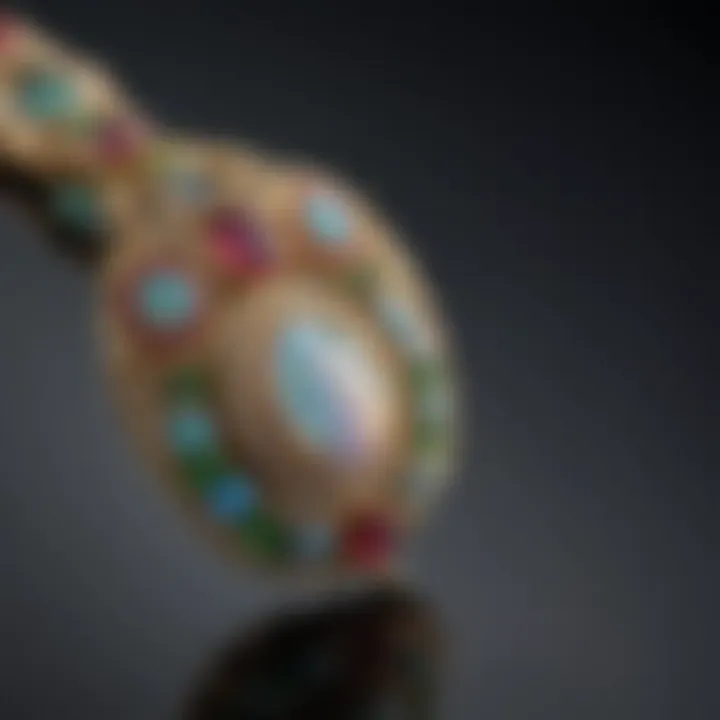
To summarize, the rich symbolism and meanings of opals encompass a blend of emotional significance and cultural narratives. Their beauty and depth resonate not just visually but also spiritually, providing a unique connection to the human experience.
Symbolism and Meaning of Tourmaline
Tourmaline holds a significant place in the realm of gemstones, especially given its array of colors and its cultural symbolism. The stone is believed to carry various meanings, making it cherished by many. The importance of understanding these meanings is critical for collectors, jewelry designers, and enthusiasts alike, as it adds a layer of personal and emotional significance to the pieces they admire or create.
Affirmations and Healing Properties
Many believe that Tourmaline possesses unique healing properties. Each color variation of Tourmaline is thought to resonate with specific energies. For example, while pink Tourmaline is associated with love and emotional healing, green Tourmaline is often linked to prosperity and abundance. These stones are used in affirmations, a practice where individuals state positive intentions or goals to manifest desirable outcomes.
Common affirmations associated with Tourmaline include:
- "I am grounded and secure in my decisions."
- "I embrace my inner strength and creativity."
- "Love flows freely into my life."
Furthermore, users have reported that carrying or wearing Tourmaline can help in dispelling negative energy and promoting a sense of well-being. The belief in its protective qualities makes it a favorite among those who seek to create a harmonious environment in their lives.
"Tourmaline is not just a beautifully versatile gemstone; it is a conduit for emotional clarity and strength."
Cultural Relevance and Usage
The cultural significance of Tourmaline transcends borders and epochs. In ancient history, various cultures utilized Tourmaline for its believed powers. For instance, in African cultures, the stone was often used for protection and healing rituals. Native Americans valued it equally, seeing it as a spirit stone and a bridge to greater wisdom.
Tourmaline also finds its place in modern jewelry design. Its diverse color palette allows designers to create unique pieces that can symbolize personal milestones or express individual style. It is increasingly popular in engagement rings and fashion accessories, celebrated for its ability to complement various outfits.
Overall, the blend of aesthetics and metaphysical properties makes Tourmaline a meaningful choice for many. Understanding its symbolism and relevance helps foster a deeper connection with the gemstone, enriching the experience of owning or gifting Tourmaline jewelry.
The Role of October Birthstones in Jewelry
The significance of October birthstones, Opal and Tourmaline, in jewelry design cannot be overlooked. These gemstones offer unique attributes and aesthetics that appeal to a wide range of consumers. Both stones are not only celebrated for their beauty but also for the meanings they impart.
Incorporating Opal and Tourmaline into jewelry designs becomes a way to celebrate personal milestones, define styles, or signify emotions. They serve as thoughtful gifts for birthdays, anniversaries, or any special occasion, enhancing their value beyond mere adornment. Moreover, the intrinsic qualities of these stones make them versatile in various jewelry pieces.
Popular Jewelry Designs Featuring Opal
Opal has captivated artisans and wearers alike with its vibrant play of color and unique textures. Common designs include:
- Statement Rings: Often featuring a large, opalescent stone surrounded by diamonds, these rings become the focal point of any outfit.
- Necklaces: Opal pendants come in various shapes and sizes, frequently designed to hang delicately from a chain.
- Earrings: Whether in stud or drop styles, opal earrings add an element of surprise to any jewelry collection.
Each design magnifies the stone's properties, showcasing its iridescence and color shifts. Jewelry featuring Opal is often seen as an expression of individuality, making them a favorite among those who wish to break away from mainstream designs.
Tourmaline Jewelry Trends
Tourmaline offers a spectrum of colors and is renowned for its versatility in jewelry. Current trends reflect this diversity with several features:
- Multi-Color Combinations: Jewelry designers frequently use several shades of Tourmaline in one piece, creating bold looks.
- Raw Tourmaline Designs: The appeal of natural, uncut Tourmaline has grown. This unique presentation offers a more organic feel.
- Layering Styles: Multi-stacking rings or layered necklaces are trendy, allowing wearers to mix colors and shapes.
Tourmaline's adaptability makes it suitable for both casual and formal settings, appealing to a broader audience. With sustainable practices gaining traction, ethically sourced Tourmaline is increasingly favored in the jewelry market, further enhancing its value.
"The beauty of Opal and Tourmaline in jewelry goes beyond aesthetics; it connects wearers to personal and cultural narratives."
Care and Preservation of Opal and Tourmaline
Caring for gemstones is essential for maintaining their beauty and longevity. Opal and Tourmaline, as October birthstones, require specific attention to ensure they remain in pristine condition. Each stone features unique properties and vulnerabilities that necessitate appropriate cleaning and preservation techniques. Proper care not only enhances the aesthetic appeal but also retains their value over time.
Cleaning Techniques for Opal
Opal is known for its stunning play of colors and delicate structure, which makes cleaning an important aspect of care.
- Use Gentle Cleaning Agents:
- Use a Soft Cloth:
- Avoid Ultrasonic Cleaners:
- Dry Properly:
- Mild soap mixed with warm water is suitable. Avoid harsh chemicals that can damage the stone's surface.
- A lint-free, soft cloth is best. It prevents scratches and minimizes damage.
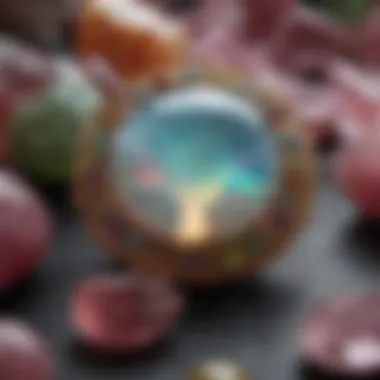
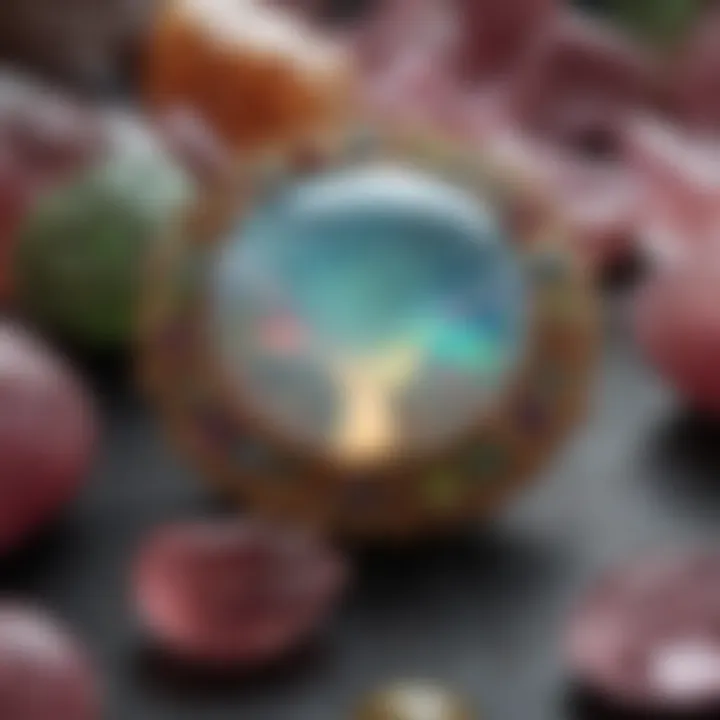
- Ultrasonic cleaners can be too intense and may cause fractures in the stone.
- Always dry opals thoroughly after cleaning. Water can damage them if left trapped.
Regular cleaning, about once a month, can help maintain the brilliance of opals and keep them looking their best.
"The right care can significantly extend the life and luster of opal jewelry."
Caring for Tourmaline
Tourmaline is more durable than opal but still requires regular care to keep it stunning.
- Avoid Extreme Temperatures:
- Gentle Cleaning Practices:
- Storage Tips:
- Check Settings Regularly:
- Sudden changes in temperature can lead to cracks. Keep them in a stable environment.
- Use a soft brush and warm soapy water for cleaning. Ensure all soap is rinsed off.
- Store Tourmaline away from other jewelry to prevent scratching from harder stones. Soft pouches or separate compartments are ideal.
- If Tourmaline is set in jewelry, check settings periodically for any loosening.
By following these guidelines, both opal and tourmaline can shine brightly for years to come, making them cherished pieces in any collection.
Market Trends for Opal and Tourmaline
Understanding the market trends for Opal and Tourmaline is crucial for enthusiasts and collectors. It allows individuals to make informed decisions regarding purchases and investments. This section explores key aspects of the market, including the investment potential of these gemstones and emerging patterns in consumer preferences.
Investment Potential of Gemstones
The investment potential of gemstones continues to attract attention from collectors and investors alike. Opal, with its unique play-of-color, offers a rare opportunity for value appreciation. The most sought-after varieties, such as Black Opal, can command significant prices. Similarly, high-quality Tourmaline, particularly the rare Paraiba version, has gained recognition for its rising value in the gemstone market.
Several factors influence the investment potential of these gems:
- Rarity: The scarcity of certain opal types and the limited availability of premium Tourmaline variants enhance their investment allure.
- Market Demand: Increasing recognition of these gemstones in the luxury market drives up their desirability.
- Quality: Higher quality specimens, verified by reliable grading, tend to maintain or increase their value over time.
Investors seeking diversification may find that including Opal and Tourmaline in their portfolios provides unique advantages. The rising popularity can lead to profound returns, especially as trends shift towards rare and ethically sourced stones.
Emerging Patterns in Consumer Preferences
Current consumer preferences in the gemstone market indicate a noticeable shift towards sustainability and personalization. As more buyers become aware of ethical sourcing, gemstones like Opal and Tourmaline benefit from their diverse origins and availability through ethical channels.
Here are some notable trends:
- Customization: Buyers increasingly prefer bespoke jewelry. This customization allows consumers to choose specific gemstone types, engaging more deeply with the stones' symbolism and meanings.
- Sustainability: There is a growing demand for ethically sourced gemstones, which encourages suppliers to adopt transparency in their practices.
- Color Diversity: For Tourmaline, the wide range of color variants appeals to consumers looking for unique pieces. From vivid greens to striking pinks, this variety meets diverse aesthetic preferences.
In summary, understanding the market trends surrounding Opal and Tourmaline equips enthusiasts and collectors with the knowledge needed to navigate their investments successfully. Market dynamics are always shifting, but the enduring allure of these gemstones guarantees their continued significance in the jewelry world.
Closure: The Enduring Allure of October Birthstones
The discussion of October's birthstones, Opal and Tourmaline, is not merely a retrospective on two beautiful gems. It captures a broader narrative about the intersection of nature, culture, and human sentiment. These gemstones stand as symbols of deeper meanings, transcending their aesthetic appeal.
Importance of Opal and Tourmaline
Opal and Tourmaline are unique in both their physical attributes and the metaphysical beliefs associated with them. Opals are often recognized for their shifting colors and play-of-color effect, which creates a mesmerizing visual experience. This characteristic makes them desirable among collectors and jewelry designers alike. Tourmaline, with its extensive range of colors, showcases nature's variability. It serves not just a decorative purpose but also a symbolic one, where each color variant carries distinct meanings.
Cultural and Emotional Relevance
Both gemstones have cultivated rich histories tied to cultural significance. Opal has often been revered in folklore as a stone of protection and inspiration, whereas Tourmaline is appreciated for its purported healing properties. These aspects resonate with many, creating a personal connection that enhances their allure.
"The beauty of Opal and Tourmaline lies in their ability to reflect human experiences and emotions. They embody stories of the Earth, history, and tradition."
Considerations for Enthusiasts and Collectors
For gemstone enthusiasts, understanding the nuances between these two stones is crucial. A focus on their market trends, investment potential, and care methods becomes a necessary part of ownership. The more one engages with these stones' qualities, the more profound the appreciation grows.
Benefits of Understanding October Birthstones
Concluding the exploration of Opal and Tourmaline, we find that these birthstones do offer an enduring allure. They are not just exquisite ornaments; they are multifaceted representations of identity, culture, and history. Each stone invites curiosity and admiration, forming connections through their stories.
This comprehensive understanding benefits anyone interested in gemstones, emphasizing the importance of knowledge in both appreciation and preservation. By exploring these remarkable stones, we celebrate a profound connection to our planet's beauty and the meanings we attach to these natural wonders.



